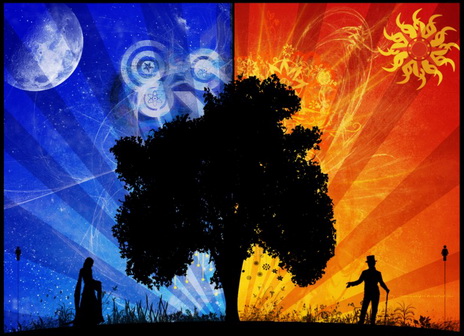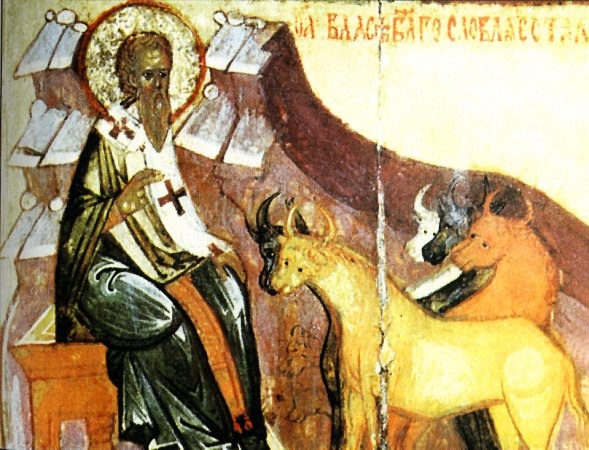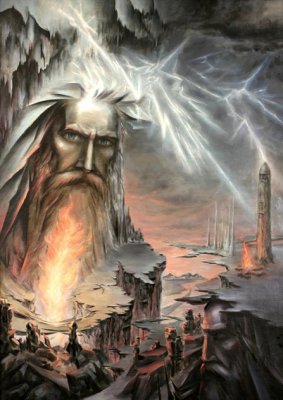|
Publications ONWARD TO THE PAST
The day of vernal equinox came it is a date which our ancestors believed as the beginning of the year. More precisely the new summer because the counting was by years. Since olden times in Russia they believed this time as the beginning of the revival of nature. Day will be longer than the night, in the trees will begin to swell buds . It is possible that soon we'll even hear the first vernal thunder. Vernal Equinox is one of the unique phenomena of nature, the essence of which, speaking in scientific language is that "at the time of equinox, the center of the Sun in its apparent motion along the ecliptic crosses the celestial equator." Speaking more simple the Earth in this day rotates around its imaginary axis passing through the poles moving simultaneously around the Sun is in such position relatively to the luminary, that the sun's rays carrying the heat energy, fall sheer to the equator. The sun moves from the southern to the northern hemisphere and in these days in all countries the day is almost equal to the night. Since 2010 to 2014 the vernal equinox occurs on March 20.
In ancient times, the coming of spring was determined by the sun and the vernal equinox days always were great holidays. It was believed that from this day begins renovation of nature the first spring thunder, swelling buds on the trees, luxuriant, sprouting of greenery. Therefore, the day when light and darkness are equally divided, in many places of the Earth: China, Japan, India, Egypt, Iran, Afghanistan, Central Asia, they marked as the beginning of the new year.
In Japan, the vernal equinox is called Syumbun-no- hi. It is celebrated on March 21 and on March 20 in leap years. Another name for a holiday - Tunit, which means "average day". This name is connected with the fact that the vernal equinox falls in the middle of the week, called Higan, which means " the other shore." At this time, the Japanese visit the graves of their dead relatives and in Japanese gardens bloom sakura, presaging about coming of real spring. The vernal equinox, and particularly venerated in pagan faith. It was believed that on this day in the annual cycle the spring, a symbol of the revival and rebirth of nature, comes to replace winter . Rather, it is connected to the main occupation of our forefathers with agriculture.
The transition to the Gregorian calendar moved the date and for us spring formally "comes" sooner than for our ancestors. Pancake festival in pagan Russia was celebrated in the days before the vernal equinox. In contrast to mid-February, its celebration in those March days is more reasonable. In the ancient Slavs lived by the solar calendar, and dates of major holidays were tied to the solar cycle. In the year, naturally there were four basic dates: summer and winter solstices, vernal and autumn equinox. These key points divide the year into four parts each of which, in its turn, is divided in half also. The cycle of agricultural feasts is associated with the solar cycle. Slavic farmers knew excellently, when to ask the gods for rain or its cease about the sun or snow. By the way there are physical evidence to this for example ancient calendars. Summer solstice is the day of Ivan Kupala. The name itself has a Christian etymology, although in Kupala night is really carried out the ritual "Bathing." The meaning of them, as well as jumping over the fire is a ritual cleansing with water and fire. And when to clear from troubles and diseases, but if not at the culminating moment of the solar year, when there is the shortest night and longest day of the year. This time is time nature flowering. The sun moves from young spring hypostasis (Yarylo) in the summer, mature (Dazhbog). Nature is full of energy and midsummer rites connected with fertility for good reason. They are not aimed for awakening forces of nature (like spring), but sooner to give forces to ripening harvest. The last celebration corresponds to the fourth of the key points of solar year to the day of the autumnal equinox to the period of September 20-24. It is needed to say that our understanding of ancient cults, is not full. Too much has been lost that is why we can only guess. Modern Pagans include this day in the cycle of annual festivals. According to B. Rybakov, our ancestors did not celebrate autumnal equinox this day was timed to the holiday harvest. But the exact date of celebration is not so important because our ancestors knew about equinox. Day became shorter than night, Sun moved into the next hypostasis of dying, «old man». Dying on the eve of the winter solstice, it reborns next day in the guise of youth… Between these «tops» of the year are located holidays dividing the «quatters» " of the year in two.
June 4 – Yarilo's daythe beginning of summer. (The previous to it week is known as the Green Yule). This is a ritual meal in the field, boys initiation ceremonies, games, dances, often with a strong erotic aspect of ... And it is no wonder, because Yarylo is associated with life-giving force a mature nature.
November 1-7 – Svarog's days (or days of Mokos). This is a period of remembrance of ancestors, preparing for winter. Now we know western counterpart of this holiday, Halloween. Costumed people could represent of went on a spree spirits, rejoicing to the coming winter. And perhaps ancestors of the deceased later became "spirits" who was invited to the feast. But Svarog is also the patron of weddings. Because in those days were festivals the meeting of fellows with girls. Of course, the dates may be inaccurate and original meaning of many holidays has been lost. But it is important to understand that all these festivals did not appear from nothing they are caused with way of life in traditional culture. The vernal equinox is the beginning of a new agricultural summer, one of the most important celebrations of the annual cycle when the Sun- baby becomes youth and "grows", blossoming with the rest nature. Author: GeoLines.ru |


 In the last decade the day of vernal equinox fell on March 21 twice in 2003 and 2007. In other years the vernal equinox occurred on March 20. The sun will rise exactly to the east and set down exactly to the west. The equinox occurs at 31 minutes past 8 p.m. by Moscow time. In the northern hemisphere, will occur astronomical spring and in the south autumn . The vernal equinox will occur on 20 or 21 March, when the Sun passes from the southern to the northern hemisphere, and autumn equinox will begin 22 or 23 September when it moves from north to south hemisphere . In these days for all places of the Earth (excluding parts of the poles) the day is almost equal to the night. As the Sun is not point source of the light but disk small errors appear because of refraction and the fact that moment of the equinox itself is displaced relatively 6 o’clock a.m or 6 p.m of the local solar time.
In the last decade the day of vernal equinox fell on March 21 twice in 2003 and 2007. In other years the vernal equinox occurred on March 20. The sun will rise exactly to the east and set down exactly to the west. The equinox occurs at 31 minutes past 8 p.m. by Moscow time. In the northern hemisphere, will occur astronomical spring and in the south autumn . The vernal equinox will occur on 20 or 21 March, when the Sun passes from the southern to the northern hemisphere, and autumn equinox will begin 22 or 23 September when it moves from north to south hemisphere . In these days for all places of the Earth (excluding parts of the poles) the day is almost equal to the night. As the Sun is not point source of the light but disk small errors appear because of refraction and the fact that moment of the equinox itself is displaced relatively 6 o’clock a.m or 6 p.m of the local solar time. Vernal and autumnal equinoxes are the astronomical beginning of the season. The time interval between two equinoxes of the same name is called a tropical year. This year has now taken for measuring of time. In the tropical year there are approximately 365.2422 solar days. That's because of this " approximately " equinox each year falls on different times of the day moving forward approximately 6 hours every year. Therefore, in the vernal and autumnal equinox the sun rises almost exactly to east and sets almost to the west. After the vernal equinox (in the northern hemisphere) the sun rises north of east and sets north of west and after the autumnal equinox it rises south of east and sets south of west.
Vernal and autumnal equinoxes are the astronomical beginning of the season. The time interval between two equinoxes of the same name is called a tropical year. This year has now taken for measuring of time. In the tropical year there are approximately 365.2422 solar days. That's because of this " approximately " equinox each year falls on different times of the day moving forward approximately 6 hours every year. Therefore, in the vernal and autumnal equinox the sun rises almost exactly to east and sets almost to the west. After the vernal equinox (in the northern hemisphere) the sun rises north of east and sets north of west and after the autumnal equinox it rises south of east and sets south of west. Many nations have kept the vernal equinox as a holiday in the calendar. For example, in Persian it is called Nowruz, which means "new day". Rooted in the tradition of ancient farmers in the Middle East and Central Asia, the festival has become an integral part of the culture of many peoples professing Islam. In the CIS, it is celebrated as a national one Tatars, Kazakhs, Bashkirs, Kyrgyz, Tajiks, Uzbeks, and many other nations. In some countries, Navruz is declared as public holiday and public holiday.
Many nations have kept the vernal equinox as a holiday in the calendar. For example, in Persian it is called Nowruz, which means "new day". Rooted in the tradition of ancient farmers in the Middle East and Central Asia, the festival has become an integral part of the culture of many peoples professing Islam. In the CIS, it is celebrated as a national one Tatars, Kazakhs, Bashkirs, Kyrgyz, Tajiks, Uzbeks, and many other nations. In some countries, Navruz is declared as public holiday and public holiday. In the Christian religion, the day of the vernal equinox is always attached great importance. Date of Easter, which is celebrated every year in different times was counted from this day. Everything began in 325 BC, when the Council of Nicaea was held where the Julian calendar was adopted for the entire Christian world. By resolution of the Council of Nicaea equinox, was obliged to falls on March 21"forever", as it was in Council year. But in the end of the XIV century Christian church suddenly discovered that the vernal equinox for a long time does not coincide with the March 21, and furthermore, every 128 years comes earlier one day. When the error was noticed, the difference was 10 days, by Julian calendar the time of the equinox was on March 21 but in reality it had come on March 11. This fact was pointed out by many astronomers and the clergy was going to hold a reform, but each time it was postponed by various reasons. At last, Pope Gregory XIII announced a competition to design a new calendar. The design Italian mathematician . Lilio has won. In 1582 Pope issued a special bull, according to which the count of days was moved to 10 days forward and Friday after of Thursday on October 4, 1582 was ordered to be considered not 5,but October 15. The new calendar in honour of the Pope was called Gregorian.
In the Christian religion, the day of the vernal equinox is always attached great importance. Date of Easter, which is celebrated every year in different times was counted from this day. Everything began in 325 BC, when the Council of Nicaea was held where the Julian calendar was adopted for the entire Christian world. By resolution of the Council of Nicaea equinox, was obliged to falls on March 21"forever", as it was in Council year. But in the end of the XIV century Christian church suddenly discovered that the vernal equinox for a long time does not coincide with the March 21, and furthermore, every 128 years comes earlier one day. When the error was noticed, the difference was 10 days, by Julian calendar the time of the equinox was on March 21 but in reality it had come on March 11. This fact was pointed out by many astronomers and the clergy was going to hold a reform, but each time it was postponed by various reasons. At last, Pope Gregory XIII announced a competition to design a new calendar. The design Italian mathematician . Lilio has won. In 1582 Pope issued a special bull, according to which the count of days was moved to 10 days forward and Friday after of Thursday on October 4, 1582 was ordered to be considered not 5,but October 15. The new calendar in honour of the Pope was called Gregorian. 11–18 February – Veles days. On the household level Veles is the patron of cattle in the broadest sense the bearer of material goods and wealth. Why does the day in the middle of winter is dedicated to Veles ? Because Veles is the lord of the dead world it is his main hypostasis; It is not surprisingly that the Veles day is celebrated in the apogee of the winter period in the most fierce cold. Buteverything in the world is cyclical, and right now a new summer a new life cycle arises. In the Christian era Velezs was replaced by Christian patron of cattle by saint Blasius, according to his Life, during the persecution of Christians he hid in a cave, to which the wild beasts approached receiving his blessing and healing.
11–18 February – Veles days. On the household level Veles is the patron of cattle in the broadest sense the bearer of material goods and wealth. Why does the day in the middle of winter is dedicated to Veles ? Because Veles is the lord of the dead world it is his main hypostasis; It is not surprisingly that the Veles day is celebrated in the apogee of the winter period in the most fierce cold. Buteverything in the world is cyclical, and right now a new summer a new life cycle arises. In the Christian era Velezs was replaced by Christian patron of cattle by saint Blasius, according to his Life, during the persecution of Christians he hid in a cave, to which the wild beasts approached receiving his blessing and healing. July 20 – Perun's day (and the precedin to its week). Water-related rituals and beliefs (in particular, the prohibition of bathing) can be explained by attempt to save the ripening crop from rain. Perun is the god of warriors, but for farmers he is the god of thunder. Ritual games are great to appease Perun. And not only they ... Pouring ritual, perhaps, carries echoes of the ancient sacrifices.
July 20 – Perun's day (and the precedin to its week). Water-related rituals and beliefs (in particular, the prohibition of bathing) can be explained by attempt to save the ripening crop from rain. Perun is the god of warriors, but for farmers he is the god of thunder. Ritual games are great to appease Perun. And not only they ... Pouring ritual, perhaps, carries echoes of the ancient sacrifices.



